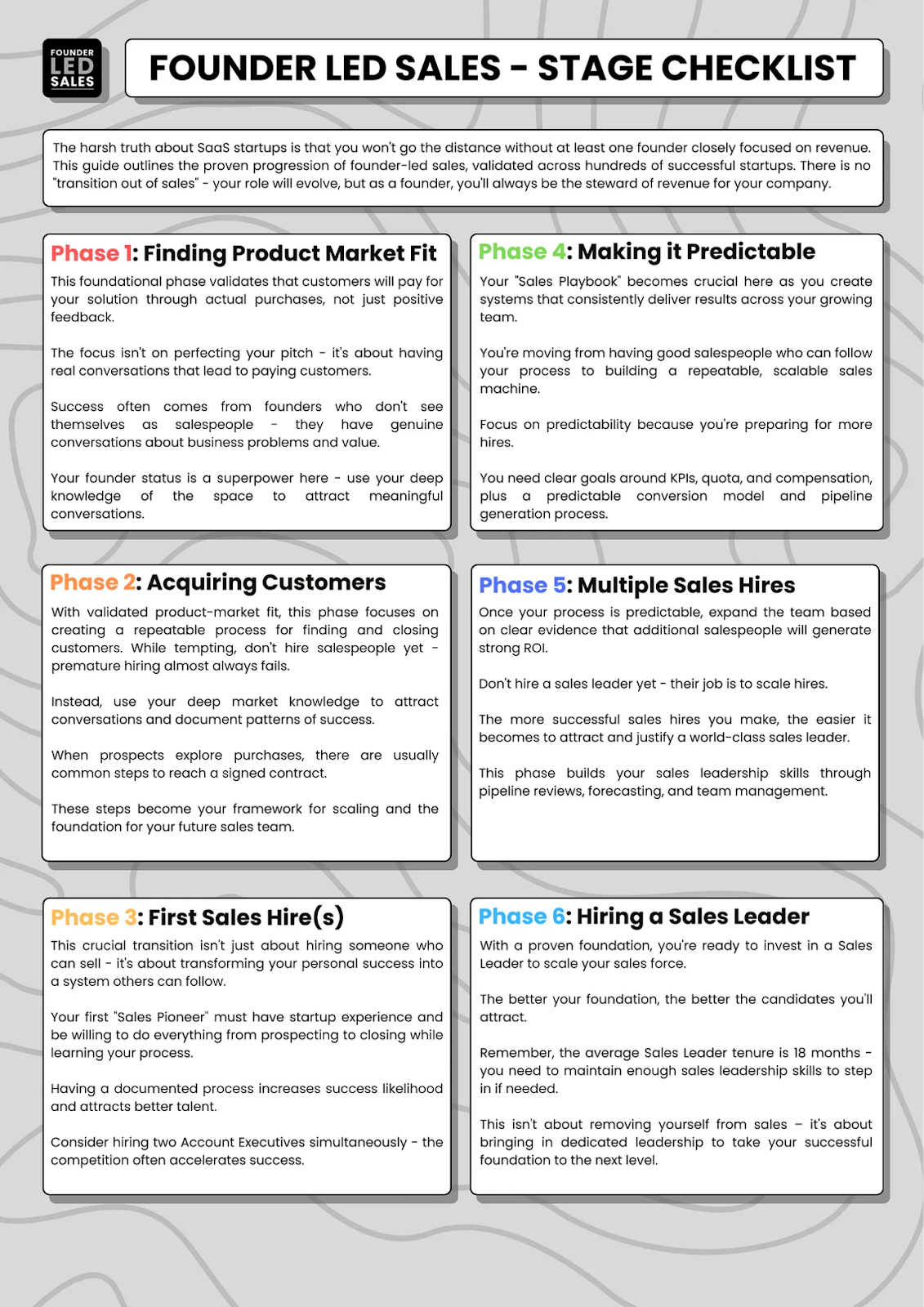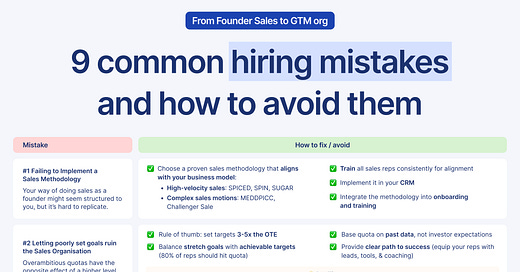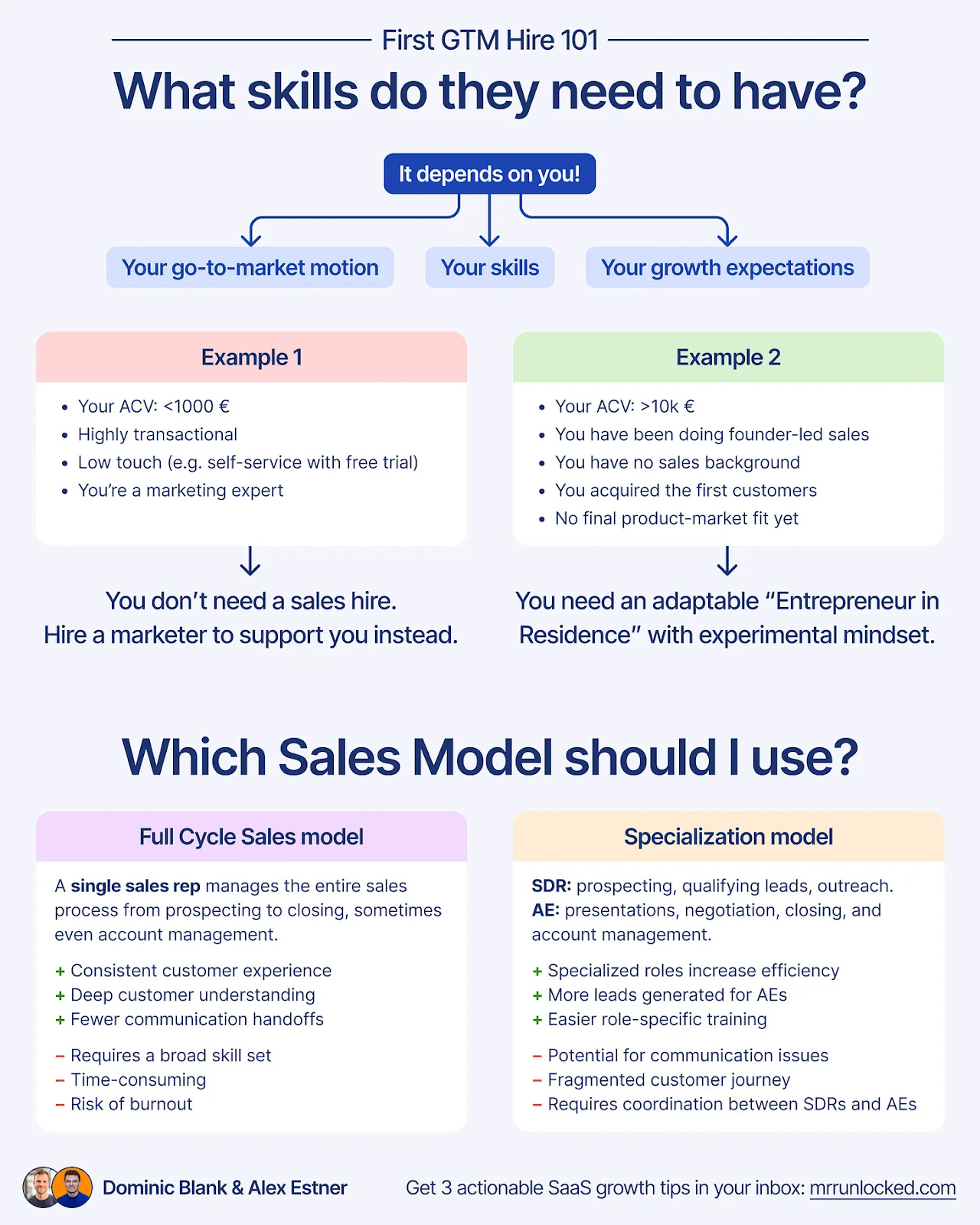Hiring your first GTM team: 9 common mistakes and how to avoid them
Bonus: Free Job description template + free consulting session
Hey - it’s Alex - this time together with Elvin Kingma and Machiel Kunst!
Today we cover:
1️⃣ 9 common hiring mistakes from founder sales to a proper GTM org
2️⃣ The right first sales hire - your pioneer sales
3️⃣ Job description templates
Bonus: List of my vetted Go-to software tools for early-stage SaaS startups
In case you missed the last 3 episodes:
✅ Social Listening Guide: Identify high-intent mentions to grow your SaaS
✅ 4 Allbound Playbook to Generate Pipeline in 2025
✅ The Ultimate Guide on Case Studies & Testimonials
Top Links:
👉 Free Job Description Template (Sales Pioneer & Head of Sales)
👉 Get free 30-minute hiring consulting from Bluebird (send me a DM)
A quick word from our sponsors
📢 Anima— Europe's fastest-growing healthtech company is HIRING (Job Alert)
Anima is Europe's fastest-growing healthtech company, pioneering agentic AI in precision medicine. We experienced 450% growth scaling from $150k to $7m ARR, and we’re cashflow positive.
Anima is looking for exceptional founders, sales leads, and engineers to join the mission. Remote-first (EU/NA). Fill out the form to speak to the founder, Shun.
📢 Attio— The AI-native CRM that’s built for the future
Attio is the CRM for the AI era. Connect your email, and Attio instantly builds your CRM - with every company, every contact, and every interaction you’ve ever had, enriched and organized. Join industry leaders like Flatfile, Replicate, Modal and more.
Want to reach 4500+ early-stage SaaS founders/leaders? Sponsor the next newsletter.
Going from Founder Sales to a proper GTM organisation
In previous episodes, we’ve talked about:
However, Elvin & Machiel have worked with hundreds of founders and helped many hire their first GTM talent (predominantly on the sales side). They’ve noticed a few common mistakes most founders make in this process.
A topic that I also face a lot when working with founders building their GTM foundation.
So we decided to join forces and write a guide on the 9 most common hiring mistakes (for the first GTM hires).
Let’s understand what exactly happens when you set out to build your first GTM org.
As a founder, you might be great at selling your solution, but transitioning out of sales and creating a successful, replicable, scalable motion with a team is often challenging.
This is the part where founders get many concepts wrong and make costly mistakes due to inexperience in GTM strategy, process setting, and execution.
This is especially true for first-time and technical founders who have limited prior GTM experience.
In the visual below, you see the 6 phases of Founder-Led Sales (by Seth DeHart, creator of the founderledsales community), where you can see that hiring is a key aspect of it.

So, to make sure you master founder-led sales, we want you to prevent the most common hiring mistakes.
That’s why today, we will uncover the 9 most common mistakes that founders should avoid when it comes to hiring the first GTM team for your SaaS startup.
Let’s dive right in!
9 common hiring mistakes
Mistake 1: Failing to Implement a Sales Methodology
Before we go into hiring the right salespeople, we need to make sure we have the right internal methods in place for better execution.
Often, sales reps are hired to try and replicate the founders’ success, however, this often fails. Sales Methods are introduced for a reason.
Your way of doing sales as a founder might seem structured to you, but it’s hard to replicate. Many startups fail because they operate without a structured sales methodology!
Why does this happen?
Your way of doing sales is hard to replicate
⇩
You miss a common framework
⇩
It’s harder to measure performance
⇩
You won’t have insights into what works and what doesn’t
⇩
Coaching is ineffective
⇩
Scaling becomes harder
How can you fix it?
You should choose a proven sales methodology that aligns with your business model -
✅ High-velocity sales motions for SMBs can go for SPICED or SPIN selling,
✅ Complex sales motions selling to enterprises can go for MEDDPICC, Command of The Message, and The Challenger Sale.
Once you have a sales method in place, you can take the following steps:
✅ Train all sales reps consistently on it to ensure alignment
✅ Implement it in your CRM to measure performance and understand conversions
✅ Integrate the methodology into onboarding and ongoing training.
After doing this, onboarding, training, and coaching become more effective, as you can now teach sales reps HOW to do sales in your organization. Additionally, the data on your process will now become a baseline for further improvement areas in the sales process.
💡ProTip: Add sales call recording tools (e.g., TLDV, Fireflies, Gong, Chorus) to analyze top-performance behaviors and implement this back into the sales process to optimize it.
Mistake 2: Letting poorly set goals ruin the Sales Organisation.
Once you have a process in place, you’ll start having repeatability and predictability, but don’t let this trigger you into setting overambitious quotas. When targets are too high, even great sales reps will feel discouraged and leave you for more achievable opportunities..
❌ Overambitious quotas have the opposite effect of a higher level of revenue.
Sales reps get stressed out, and prospects feel this pressure. Conversions drop, and churn increases, resulting in lower commissions and unhappy sales reps. Eventually, this leads to employee churn and leaves your company with less revenue.
How to fix your quota?
✅ The general rule of thumb is to set targets that are 3-5x the OTE, (but this is too simple to just state without understanding all aspects of your organization that affect this)
✅ Base quota on past data, not investor expectations
✅ Balance stretch goals with achievable targets (modern benchmarks suggest 80% of reps should hit quota)
✅ Provide a clear path to success, and equip your reps with the required leads, tools, and coaching
This is better for team morale, which, again, is felt by prospects. The result is a higher close rate, more revenue, and a great amount of time and money saved by not having to replace your team.
💡Pro Tip: In the early stages, giving a flat % over closed revenue and not setting targets can help create great momentum without unnecessary pressure. This also allows you to create valuable data over time, on which you can create more structure for goals and commission models.
Mistake 3: Hiring the Wrong First Salesperson (Pioneer AE)
Hiring the right first salesperson for your business can have a multiplier effect, while hiring the wrong first salesperson creates the opposite effect.
Getting this first profile correct is fundamental and will save you.
Let’s start with what not to look for in a pioneer or founding AE:
❌ 1. Profiles that come from big companies (e.g., Salesforce, Oracle, SAP, Microsoft, Cisco)
These AEs are used in structured environments and for great sales enablement. They won’t find this in your organization and are typically not entrepreneurial self-starters. They struggle in unstructured early-stage environments and are often set in their way, trained on a specific playbook that might not work in your sales motion
Instead, you should look for an AE who -
✅ Has startup experience.
Know what it means to work in an early-stage environment.
✅ Can prospect from scratch (full sales cycle), not just close inbound leads.
Does what it takes to close customers. It’s more about testing different things and building early sales playbooks.
✅ Has a strong track record in building pipeline
You can’t invest in teaching them. So invest in someone who did it before.
✅ Is a Challenger Seller
Someone who can meet customers wherever they are in their buying journey and educate them. Someone who can consult and evangelize your solution.
✅ Has grit, adaptability, and a strong work ethic (prioritize this over industry experience)
Being early-stage is tough. Lots of Nos. Sometimes buggy products. No existing brand power. Find someone who can push through.
✅ Has a strong willingness to build, test, and execute
You don’t know everything. Look for someone who wants to build first sales playbook with you.
In case you have already hired one, here are a few signs of the wrong first sales person:
❌ 1. Lack of product knowledge
A lot of (senior) sales reps, if they start working in an early-stage start-up, don't really understand the product. They do not take enough time to understand the customer's perspective and challenges, nor to create a value-selling strategy. Make sure your first sales rep spends enough time understanding the product (& the customer).
❌ 2. Not willing to become an industry expert
This point is closely related to point 1. If your sales rep is not willing to dive deep into the industry, gain know-how about the specifics, and become an industry expert, that's a bad sign.
❌ 3. Not keen on building an industry network
Word of mouth, warm intros, high-touch relationships with customers, and referral marketing are key growth strategies in the early stage. That's why it is super important that your customer-facing employees (sales, customer success, support & marketing) grow their industry-relevant network.
❌ 4. Always sells with massive discounts
Only being able to sell with massive discounts is a sign of a lack of sales skills. Most sales reps use discounts because they have no other idea how to close a deal or create urgency. Make sure your first sales rep knows about value-based selling/solution selling, so they find other ways to convince the customers.
❌ 5. Competition focused
The wrong sales reps spend too much time comparing with the competition and blaming missing product features for unsuccessful sales performance. The best salespeople know the competition well and can adapt their pitch to the competition if needed. For good sales reps, competition is just part of the game, and they want to beat them.
❌ 6. Lacks accountability & blames others
Wrong sales reps blame others, and they miss accountability for hitting their goals. Mostly, they blame marketing, product, or support. Even if this is usually true, it's a bad sign.
❌ 7. Missing growth mindset
Early-stage sales is a tough game. Mostly, you try to convince customers of an early (buggy) MVP. You need to be creative, smart, and always find new ways. Great salespeople have a growth mindset.
Sales reps who worked in start-ups or scale-ups are comfortable with ambiguity and a lack of process. They can even help shape your sales strategy and process (if they’ve been taught in previous experiences). They can lay the groundwork for your repeatability and are fine with both executing and building at the same time.
Some examples of profiles that embody these characteristics and skills;
Jan Seifert - Founding AE at Parloa
Dave Jenkins - Founding AE at Contentful
Emil Holl - Founding SDR / AE at Personio
Alyse Andre - Pioneer AE Ultimate.ai / Rematic
Moritz Ernst - Pioneer AE - HYRE, PlayPlay, Vidlab 7
Mistake 4: Hiring a Sales Leader Before Proving Product-Market Fit
We’ve seen many founders hire a sales leader as their first GTM hire to have someone build the strategy and the processes, and this often fails.
This is because there isn’t a repeatable process yet, and even a great Head or VP of Sales will struggle without a clear product-market fit.
Too often, sales leaders haven’t been hands-on for a while, they typically try to hire AEs and build the strategy and process in parallel. This is a costly approach.
What can you do instead?
✅ First, hire individual contributors (Account Executives) who can validate the sales process.
✅ Once sales reps consistently hit quota, bring in a leader to scale the team.
✅ If needed, hire a fractional VP of Sales for guidance without a full-time commitment first.
💡Pro Tip: A Pioneer AE can be well-equipped to help build the sales process/motion and can be a great operating addition to a GTM advisor. Many pioneer/founding AEs don’t look for a fancy leadership title. They love to get stuck in deals and go the business-building way, which might naturally develop them into future leaders of your business.
Mistake 5: Hiring Leaders (Who Are Too Strategic) Too Early
When you hire your first commercial leader, don’t hire someone too strategic. You don’t need someone full of high-level ideas in your early stages. You need a hands-on executor who can get things done.
In short, you don’t need a strategist, you need an executor. Why? Because a strategy without execution slows down sales growth. CCOs or CRO’s don’t want to get hired to operate sales themselves, regardless of how hands-on they are.
They come in once there’s an established repeatable process in place and a solid product-market fit that can be scaled. They bring cross-functional expertise and can align market, sales, and CS when they are working with more mature teams.
In your early stages, a GTM advisor or fractional VP can have the same effect without giving away the C-level position to a more permanent hire down the line.
Here’s what you should do:
✅ Hire a Head of Sales or VP who can build, implement, test, and iterate.
✅ Make sure your early-stage Sales Leader is able to sell and scale before you bring in a CRO.
✅ Look for candidates with execution-driven experience, not just high-level strategy.
✅ Ask HOW questions -
How did you implement that strategy/process?
How did you pick that strategy/process?
How did you get it from 0 to 1 - 1-5M+?
How did you test, adjust, and scale it?
If their answers stay high-level or sound like something a mid-level manager executed, you’ve got a strategist. If they can they walk you through the specific steps they took? That’s your executor.
Mistake 6: Hiring only ‘cheap’ salespeople
Companies often try to save money by hiring cheaper, less experienced salespeople.
The truth is, whether or not you think salespeople are overpaid, it’s completely irrelevant.
In the end, you need to pay what the market is paying, or you won’t be able to attract the right talent.
This matters because the best salespeople deliver significantly better results, making them worth the investment. Additionally, you don’t risk losing your reps to better-paying offers out there.
What can you do about it?
✅ Pay market-competitive salaries to attract top talent.
✅Avoid rigid salary structures that prevent hiring top talent - if a sales rep can’t calculate their commission, your comp plan is too complex.
💡Pro-Tip: Use ROI calculations to justify higher pay (e.g., a top salesperson can exceed targets by 20% on 600K and bring in 120K or more, which would mean they bring in more money and can cost a bit more as well)
Mistake 7: Being slow in the hiring process
Speed in the hiring process matters more than you think.
You can be the best in terms of salary, product, growth rate, and internal processes, but top candidates might still pick a different option over you because it takes you too long to hire, losing strong candidates to faster-moving competitors.
The best candidates get multiple offers within weeks. Especially, SDRs with good academia and sales acumen typically have several offers to entertain and have the luxury to pick. The same goes for strong AE profiles, even more so when they have the pioneering ability.
This is the most common mistake, yet it’s the easiest to fix:
✅ Manage expectations - define a clear hiring process and communicate it. Don’t exceed 5 steps in the process (3-4 steps are ideal)
✅ Simplify decision-making with a clear scoring system
✅ Balance thoroughness with urgency—move fast without skipping key evaluation steps.
✅ Be fast and transparent in updating candidates on next steps - don’t let them wait 1+ week for feedback
✅Use stakeholders (like recruiters) to keep candidates engaged if you need more time to compare different candidates
💡Pro-Tip: When you feel like you’re speaking to a superstar after the first interview, schedule all rounds immediately. This speeds up the process tremendously. If the candidate does the next interview poorly, you can still cancel the other interviews.
Mistake 8: Founders Stop Selling Too Soon
Founders are the best people to sell the vision, they are the ones to close the first deals and build the first levels of repeatability in their sales cycle. They keep the product team informed about customer feedback and provide tons of value in exchange for revenue with customers. Yet, Founders often assume they should stop selling after hiring their first sales reps, as for many founders, sales might not come naturally and can be a frustrating process.
However, when things fall apart in sales, and the founders are not involved, it is still their responsibility. They have to stay close to the sales team, or they’d take too much risk when revenue starts to slip. You need to stay involved and keep a pulse on the ever-evolving product-market fit.
Tips to balance out your involvement in sales as a founder
✅ Founders should remain engaged in high-stakes deals and key partnerships.
✅ They must ensure product-market fit before handing off sales completely and remain close to the customer to understand what changes.
✅ Develop a transition plan where sales leadership gradually takes over.
✅ Once you have success, have a sales leader in place - only then can you start being less involved as a founder.
Mistake 9: Hiring purely on experience/skills (and neglecting cultural fit)
While the right skill sets and experience are super important, attributes like cultural fit and passion are not less important. It's crucial to assess candidates holistically to ensure they align with your company's values and mission.
That’s it - these are the 9 most common hiring mistakes for early-stage SaaS founders.
We hope this guide will prevent you from making the same mistakes with your startup.
To make it easier for you to hire the right talent, we have something for you 🎁.
Bonus 1: Job Description Templates for your GTM team
These are FREE Job Description Templates that will help you avoid these mistakes and hire the right talent. You will get access to -
P.S. If you are hiring GTM roles right now, we’ve got you covered!
Bonus 2: Free 30-minute Hiring Consultation
Bluebird offers a free consulting session for MRR Unlocked subscribers.
In this call, Elvin Kingma or Machiel Kunst will go over your hiring strategy (hiring process/job posts/profile descriptions/salary benchmark, etc.) and consult on how to optimize it.
Completely for free. No strings attached.
All you need to do is reach out to me (via LinkedIn or respond to this email), and I will connect you.
Happy growth 🚀
3 ways I can help you grow your SaaS to €1 million ARR 👇
1️⃣ Build your SaaS GTM strategy with my free Workbook (helped 5000+ SaaS leaders)
2️⃣ Get access to 100+ actionable SaaS growth tactics (helped 250+ SaaS leaders)
3️⃣ Work 1-on-1 with me - GTM Advisory for SaaS founders from 0€ to €1 million ARR












